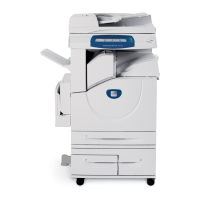211
1. Start a web browser.
2. Enter the machine’s IP address, beginning with “https,” into the Address box of your web browser,
and press the Enter key.
Example:
https://192.168.1.1/
3. Click the Properties tab.
4. Click [+] on the left of PKI Settings (Public Key) to display the items in the folder.
5. Click SSL/TLS Settings.
6. Generate a certificate.
a. Click the Generate Self-Signed Certificate button.
b. Set the size of the Public Key as necessary.
c. Set Issuer as necessary.
d. Click the Generate Certificate button. When a screen to enter the user name and password
appears, enter the System Administrator user ID and password into User Name and Password,
and then click OK.
Note: The default user ID is "11111" and the default password is "x-admin".
7. Refresh the web browser.
8. Click [+] on the left of PKI Settings (Public Key) to display the items in the folder.
9. Click SSL/TLS Settings.
10. Select the Enable check box for SSL / TLS Server Communication.
11. Check the SSL / TLS Port Number.
Note: The correct port to use is 443. Do not use the numbers of any other ports.
12. Apply the settings.
a. Click Apply.
b. The right frame on the web browser will change to the machine reboot display.
c. Click Reboot Machine. The machine will be unavailable for a short period of time.
d. Refresh the web browser to see if the Certificate Management hot link is now available under
the PKI Settings folder on the Properties page of Internet Services. Use this link to manage all
the digital certificates, of various types, stored on the machine.

